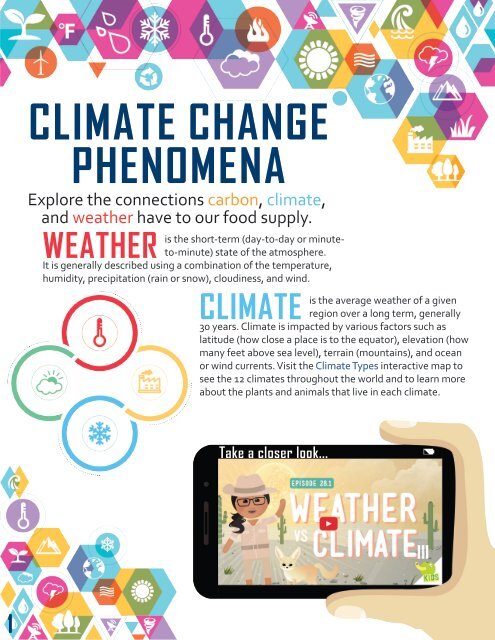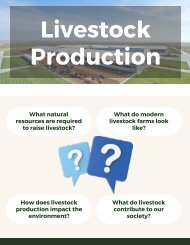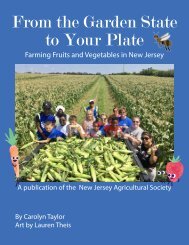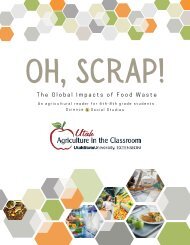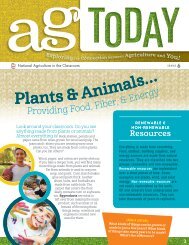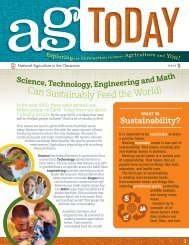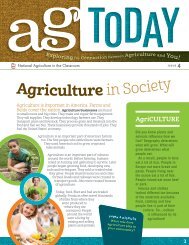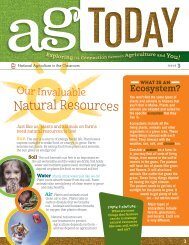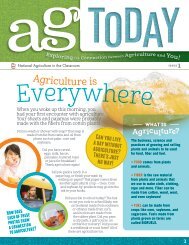Climate Change Phenomena
Explore the connections carbon, climate, and weather have to our food supply.
Explore the connections carbon, climate, and weather have to our food supply.
You also want an ePaper? Increase the reach of your titles
YUMPU automatically turns print PDFs into web optimized ePapers that Google loves.
CLIMATE CHANGE<br />
PHENOMENA<br />
Explore the connections carbon, climate,<br />
and weather have to our food supply.<br />
WEATHER<br />
is the short-term (day-to-day or minuteto-minute)<br />
state of the atmosphere.<br />
It is generally described using a combination of the temperature,<br />
humidity, precipitation (rain or snow), cloudiness, and wind.<br />
CLIMATE<br />
is the average weather of a given<br />
region over a long term, generally<br />
30 years. <strong>Climate</strong> is impacted by various factors such as<br />
latitude (how close a place is to the equator), elevation (how<br />
many feet above sea level), terrain (mountains), and ocean<br />
or wind currents. Visit the <strong>Climate</strong> Types interactive map to<br />
see the 12 climates throughout the world and to learn more<br />
about the plants and animals that live in each climate.<br />
Take a closer look...<br />
1
How does CLIMATE impact<br />
our food supply?<br />
Some climates are too cold or too dry to grow food. On another hand, other climates may<br />
be too wet to grow most of the foods we eat. Luckily, there are climates throughout the<br />
world that are ideal for the growth of many crops and to raise livestock, allowing us to<br />
consume a variety of fruits, vegetables, grains, meats, and other proteins. Does weather also<br />
impact our food supply? Yes! Even after choosing a good climate for the location of a farm,<br />
farmers are still dependent on suitable weather conditions. An abnormally late frost in a<br />
fruit orchard can diminish or destroy an entire year’s crop. Rain in the spring can help seeds<br />
germinate, but too much rain and the seeds might rot in the ground. An early snow storm<br />
could destroy an entire crop right before harvesting.<br />
CROP FORECAST<br />
CLIMATE and WEATHER<br />
are tightly correlated to our food<br />
supply. The average diet in the United<br />
States contains a variety of foods that were grown in a variety of climates. The successful<br />
growth of any food crop relies on specific climate and weather conditions.<br />
APPLES ORANGES POTATOES RICE PEAS<br />
32 O - 45 O 70 O - 90 O 60 O - 80 O 60 O - 90 O 40 O - 70 O<br />
2<br />
Apple trees need<br />
a certain number<br />
of winter days<br />
between 32°F and<br />
45°F to properly set<br />
fruit the following<br />
spring. This<br />
process is called<br />
vernalization.<br />
Citrus fruit trees<br />
cannot tolerate<br />
cold. They need<br />
warm winters and<br />
hot summers.<br />
Potatoes prefer<br />
cooler summers.<br />
They can even be<br />
planted before the<br />
last frost in the<br />
spring.<br />
Rice can be grown<br />
where nighttime<br />
temperatures stay<br />
above 60°F and<br />
where there is<br />
plenty of water. The<br />
roots should never<br />
dry out.<br />
Pea seeds can be<br />
planted before<br />
the last frost. Pea<br />
plants stop growing<br />
and producing peas<br />
when the summer<br />
temperatures reach<br />
70°F.
CARBON<br />
What is carbon?<br />
Where is carbon found?<br />
CARBON<br />
is an important element for life on earth that is found in both living and<br />
non-living parts of the planet. We encounter carbon each day of our lives.<br />
While it could be pure, elemental carbon, it is usually a compound. Examples include carbon dioxide (CO2),<br />
methane (CH4), and ethylene (C2H4). Carbon is present in all four spheres of the planet. The biosphere<br />
includes parts of the land, sea and atmosphere where life can exist, the hydrosphere includes all of earth’s<br />
water, the atmosphere is all of the gases surrounding the Earth, and the lithosphere is the rocky outer layer<br />
of earth. Places where carbon is stored are called reservoirs. The movement of carbon from one reservoir<br />
to another is called a flow. The total amount of carbon on Earth stays relatively stable except for very small<br />
additions from meteorites. However, the carbon in any of Earth’s four spheres does not remain in the same<br />
sphere forever. Carbon moves from one sphere to another in an ongoing process called the Carbon Cycle.<br />
Atmosphere<br />
Examples of natural carbon cycling<br />
Biosphere<br />
Biosphere<br />
Lithosphere<br />
Biosphere<br />
Atmosphere<br />
During photosynthesis,<br />
plants take in carbon<br />
dioxide from<br />
the air.<br />
Decomposition moves<br />
carbon from plants<br />
or animals to<br />
the soil.<br />
Respiration moves<br />
carbon from plants<br />
or animals to<br />
the air.<br />
Atmosphere<br />
Lithosphere<br />
Biosphere<br />
Hydrosphere<br />
3
CLIMATE CHANGE<br />
What is climate change?<br />
What causes it?<br />
Is it different from global warming?<br />
While there are natural fluctuations in the carbon cycle, humans have been changing the carbon flows on earth<br />
at an unnatural rate. The most significant and impactful change is the increased amount of carbon dioxide in<br />
the atmosphere. The largest source of this change is the burning of fossil fuels like coal, oil, and natural gas.<br />
Fossil fuels power our vehicles, produce electricity, heat and cool our buildings, and produce plastics. Besides<br />
fossil fuels, deforestation and some agricultural practices also put extra carbon in the atmosphere.<br />
GREENHOUSE GAS<br />
A<br />
(sometimes abbreviated GHG) is a gas in the Earth’s atmosphere<br />
that traps heat. These gases allow sunlight to pass through the atmosphere but prevent the<br />
heat from ever leaving the atmosphere. As greenhouse gases increase, the Earth gets<br />
warmer through a process called the<br />
GREENHOUSE EFFECT.<br />
Click<br />
What is the GREENHOUSE EFFECT?<br />
Meet the GREENHOUSE GASES<br />
Click<br />
Examples of how human activities accelerate carbon cycling<br />
Tilling soil moves<br />
carbon from the<br />
soil to the air.<br />
Erosion moves soil<br />
carbon to streams<br />
and rivers.<br />
Deforestation<br />
decreases<br />
photosynthesis.<br />
4<br />
<strong>Climate</strong> <strong>Change</strong> and global warming can<br />
often be confused or used interchangeably,<br />
but global warming refers only to the<br />
long-term warming of the planet since<br />
the early 20th century. <strong>Climate</strong> change<br />
includes increased temperature trends but<br />
also refers to a broad range of weather<br />
phenomena.<br />
CLIMATE CHANGE<br />
Long-term warming of the earth<br />
Sea levels rising<br />
Drought<br />
Heat waves<br />
Flooding<br />
Storm surges<br />
Extreme weather events<br />
GLOBAL WARMING<br />
Long-term warming of the earth
AGRICULTURE<br />
ADAPTATIONS<br />
MITIGATIONS<br />
What can we do in the<br />
face of climate change?<br />
There are two forms of action to respond to climate change.<br />
MITIGATIONS are actions ADAPTATIONinvolves adjusting to the actual<br />
we can take to reduce climate<br />
change by reducing the flow of<br />
carbon to the atmosphere. For<br />
example, we can reduce sources of<br />
greenhouse gases by driving less or<br />
by using energy efficient appliances.<br />
climate as well as the expected future climate so that<br />
our food supply is secure despite the weather events<br />
associated with climate change. While adaptation includes<br />
dealing with the negative effects of climate change, it also<br />
includes taking advantage of beneficial opportunities such<br />
as longer growing seasons in some regions.<br />
What are specific<br />
examples of<br />
ADAPTATION?<br />
What are specific<br />
examples of<br />
MITIGATION?<br />
In nature, we use the term “survival of the fittest.”<br />
If plants and animals adapt to their changing<br />
environment, they are likely to survive and<br />
reproduce. Can we as a human population<br />
adapt to the conditions of climate change?<br />
Can science and technology intervene to change the<br />
future climate of our globe? Scientists are researching<br />
methods of capturing carbon in the atmosphere and<br />
pumping it underground for storage. This process is<br />
called<br />
CARBON SEQUESTRATION.<br />
The faster the climate changes, the harder it may be to adapt.<br />
How can mitigations, adaptions, science, and technology<br />
be used to secure a sustainable food supply?<br />
5


